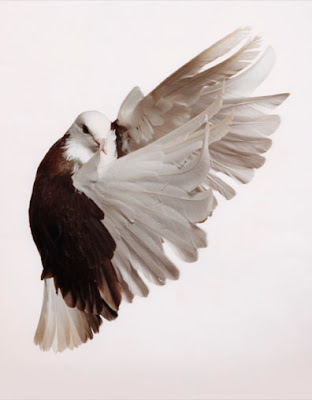Roe Ethridge at Andrew Kreps
The relationship between a photograph's overt appearance and the technical ability of the artist is what inspires Roe Ethridge. His second solo exhibition, "The Bow," stresses an interest in nature both as a physical subject and as a process of realistic depiction.
Ethridge could be considered a traditional artist, since his images are often either figures or landscapes. Each image is beautiful, yet each image of beauty obscures, or exacts through ironic counterpoint, an unseen context. The most blatantly romantic images, such as those in his "New York Water" series, Osgood Pond and Catskills, present what seem like nature pictorials straight out of Hallmark cards: the haze of late summer covering a large pond seen through a rise of fir trees, and a stream bubbling merrily through a bucolic landscape. Yet hidden in the obvious details are reasons why beauty lies to us, and why we let it. Nature is a backdrop of beautiful detail to Ethridge, but it is also merely a fact, which can be defined and compartmentalized, as it is in the title of the series, which sounds like the name of a state regulatory agency, and not a thematic depiction of beautiful scenery.
More perversely intentional are Untitled (Self Portrait) and Car Carrier. In the first, the artist sustained a nasty black eye while climbing a rock embankment. He found the image so guilelessly convincing that he was driven to document it in order to show people what a real black eye looks like. The image is painfully convincing, even as it mars his clean faced, boy next door looks. Car Carrier presents the image of a commercial freighter transporting automobiles from Europe. Ethridge was struck by the enormity of such an operation, as well as by the plain economic reality it represents. He utilized a prismatic lens to transform one ship into an army of doppelgangers whose similarity and number echo the multitude of cars each one ostensibly carries.
Combining honesty with trickery are three photographs titled simply Pigeon in which the artist "hired” a set of trained birds from Universal Studios to fly about in predetermined routines. Portrayed with a high speed lens, they take on a dramatic saintliness, like the religious familiars they really are.
Finally there is The Pink Bow, the image after which this exhibition was named. As a commercially fabricated item with humble origins, it is speciously portrayed as if it were not merely a metaphor for the sexual object it resembles, but also a commodity critique. As a gesture, it is an homage to the inspiration Ethridge derives from specific subject matter, and the specificity of the photographic image itself.
Flash Art, Vol. XXXIV, October 2002

Comments